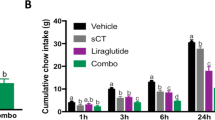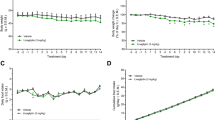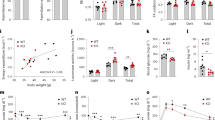Abstract
Objective:
To characterize the interactive effects of amylin with phentermine or sibutramine on food intake, body weight/composition and gene expression in diet-induced obese (DIO) rats.
Design:
DIO rats were intraperitoneally injected with a single dose of amylin (10 μg kg−1) and/or phentermine (1 mg kg−1) or chronically infused with amylin (100 μg kg−1 d−1) or vehicle with or without phentermine (0.5–10 mg kg−1 d−1) or sibutramine (3 mg kg−1 d−1) using two surgically implanted subcutaneous osmotic mini-pumps.
Measurements:
Twenty-four hour food intake, locomotor activity and components of meal microstructure (meal size, latency, duration and intermeal interval) were measured following acute administration (amylin, phentermine or amylin+phentermine). Body weight and composition (for amylin and/or sibutramine or phentermine) and metabolism-related gene mRNA expression in the liver (fatty acid synthase, stearoyl-CoA desaturase-1 and carnitine palmitoyltransferase-1) and brown fat (β-adrenergic receptors and uncoupling protein-1) were measured (for amylin and/or phentermine) after sustained infusion (2 weeks).
Results:
Acute co-administration of amylin (10 μg kg−1) and phentermine (1 mg kg−1) reduced acute food intake (up to 19 h) more than either monotherapy. In two studies, sustained subcutaneous infusion of amylin for 2 weeks decreased cumulative food intake (22%) and vehicle-corrected body weight gain (∼4–8%). Phentermine's anorexigenic (10–17%) and weight-reducing effects (∼0–5%) were only evident at the highest dose tested (10 mg kg−1 d−1). Combination of amylin (100 μg kg−1 d−1) and phentermine reduced food intake (30–43%), body weight (8–12%) and adiposity to a greater extent than either monotherapy. Amylin prevented phentermine-induced reductions in UCP-1 mRNA in brown adipose tissue. When amylin+sibutramine were infused, mathematically additive decreases in food intake (up to 45%) and body weight (up to 12%) were evident. Similar to amylin+phentermine treatment, amylin+sibutramine mediated weight loss was attributable to significant reductions in fat mass.
Conclusions:
Combined treatment of DIO rats with the pancreatic β-cell hormone amylin and phentermine or sibutramine resulted in additive anorexigenic, weight- and fat-reducing effects.
This is a preview of subscription content, access via your institution
Access options
Subscribe to this journal
Receive 12 print issues and online access
$259.00 per year
only $21.58 per issue
Buy this article
- Purchase on Springer Link
- Instant access to full article PDF
Prices may be subject to local taxes which are calculated during checkout




Similar content being viewed by others
References
Badman MK, Flier JS . The gut and energy balance: visceral allies in the obesity wars. Science 2005; 307: 1909–1914.
Morton GJ, Cummings DE, Baskin DG, Barsh GS, Schwartz MW . Central nervous system control of food intake and body weight. Nature 2006; 443: 289–295.
Mack CM, Wilson J, Athanacio J, Reynolds J, Laugero K, Guss S et al. Pharmacological actions of the peptide hormone amylin in the long-term regulation of food intake, food preference and body weight. Am J Physiol Regul Integr Comp Physiol 2007; 293: R1855–R1863.
Lutz TA, Tschudy S, Rushing PA, Scharrer E . Amylin receptors mediate the anorectic action of salmon calcitonin (sCT). Peptides 2000; 21: 233–238.
Rushing PA, Hagan MM, Seeley RJ, Lutz TA, Woods SC . Amylin: a novel action in the brain to reduce body weight. Endocrinology 2000; 141: 850–853.
Lutz TA, Mollet A, Rushing PA, Riediger T, Scharrer E . The anorectic effect of a chronic peripheral infusion of amylin is abolished in area postrema/nucleus of the solitary tract (AP/NTS) lesioned rats. Int J Obes Relat Metab Disord 2001; 25: 1005–1011.
Li Z, Maglione M, Tu W, Mojica W, Arterburn D, Shugarman LR et al. Meta-analysis: pharmacologic treatment of obesity. Ann Intern Med 2005; 142: 532–546.
Rushing PA, Lutz TA, Seeley RJ, Woods SC . Amylin and insulin interact to reduce food intake in rats. Horm Metab Res 2000; 32: 62–65.
Roth JD, Hughes H, Kendall E, Baron AD, Anderson CM . Anti-obesity effects of the β-cell hormone amylin in diet induced obese rats: effects on food intake, body weight, composition, energy expenditure and gene expression. Endocrinology 2006; 147: 5855–5864.
Chapman I, Parker B, Doran S, Feinle-Bisset C, Wishart J, Strobel S et al. Effect of pramlintide on satiety and food intake in obese subjects and subjects with type 2 diabetes. Diabetologia 2005; 48: 838–848.
Smith SR, Blundell JE, Burns C, Ellero C, Schroeder BE, Kesty NC et al. Pramlintide treatment reduces 24-h caloric intake and meal sizes and improves control of eating in obese subjects: a 6-wk translational research study. Am J Physiol Endocrinol Metab 2007; 293: E620–E627.
Aronne L, Fujioka K, Aroda V, Chen K, Halseth A, Kesty NC et al. Progressive reduction in body weight after treatment with the amylin analog pramlintide in obese subjects: a phase 2, randomized, placebo-controlled, dose-escalation study. J Clin Endocrinol Metab 2007; 92: 2977–2983.
Smith S, Klein E, Burns C, Kesty N, Halseth A, Weyer C . Sustained weight loss following 1-y pramlintide treatment as an adjunct to lifestyle intervention in obesity. Diabetes 2007; 56 (Suppl 1): A88. Abstract 335-OR.
Ferrer-Lorente R, Cabot C, Fernandez-Lopez JA, Remesar X, Alemany M . Effects of oleoyl-estrone with dexfenfluramine, sibutramine or phentermine on overweight rats. Eur J Pharmacol 2005; 513: 243–248.
Heal DJ, Aspley S, Prow MR, Jackson HC, Martin KF, Cheetham SC . Sibutramine: a novel anti-obesity drug. A review of the pharmacological evidence to differentiate it from d-amphetamine and d-fenfluramine. Int J Obes Relat Metab Disord 1998; 22 (Suppl 1): S18–S28; discussion S29.
Stock MJ . Sibutramine: a review of the pharmacology of a novel anti-obesity agent. Int J Obes Relat Metab Disord 1997; 21 (suppl 1): S25–S29.
Avenell A, Brown TJ, McGee MA, Campbell MK, Grant AM, Broom J et al. What interventions should we add to weight reducing diets in adults with obesity? A systematic review of randomized controlled trials of adding drug therapy, exercise, behaviour therapy or combinations of these interventions. J Hum Nutr Diet 2004; 17: 293–316.
Foster GD, Wadden TA, Phelan S, Sarwer DB, Sanderson RS . Obese patients’ perceptions of treatment outcomes and the factors that influence them. Arch Intern Med 2001; 161: 2133–2139.
Levin BE, Dunn-Meynell AA, Balkan B, Keesey RE . Selective breeding for diet-induced obesity and resistance in Sprague-Dawley rats. Am J Physiol 1997; 273: R725–R730.
Roth JD, Rowland NE . Efficacy of administration of dexfenfluramine and phentermine, alone and in combination, on ingestive behavior and body weight in rats. Psychopharmacology (Berl) 1998; 137: 99–106.
Boozer CN, Leibel RL, Love RJ, Cha MC, Aronne LJ . Synergy of sibutramine and low-dose leptin in treatment of diet-induced obesity in rats. Metabolism 2001; 50: 889–893.
Young AA, Rink TJ, Wang MW . Dose response characteristics for the hyperglycemic, hyperlactemic, hypotensive and hypocalcemic actions of amylin and calcitonin gene-related peptide-I (CGRP-alpha) in the fasted, anaesthetized rat. Life Sci 1993; 52: 1717–1726.
Young AA, Vine W, Gedulin BR, Pittner R, Janes S, Gaeta LSL et al. Preclinical pharmacology of pramlintide in the rat: comparisons with human and rat amylin. Drug Dev Res 1996; 37: 231–248.
Reidelberger RD, Kelsey L, Heimann D . Effects of amylin-related peptides on food intake, meal patterns, and gastric emptying in rats. Am J Physiol Regul Integr Comp Physiol 2002; 282: R1395–R1404.
Reidelberger RD, Haver AC, Arnelo U, Smith DD, Schaffert CS, Permert J . Amylin receptor blockade stimulates food intake in rats. Am J Physiol Regul Integr Comp Physiol 2004; 287: R568–R574.
Lutz TA, Tschudy S, Rushing PA, Scharrer E . Amylin receptors mediate the anorectic action of salmon calcitonin (sCT). Peptides 2000; 21: 233–238.
Foltin RW . Effects of anorectic drugs on the topography of feeding behavior in baboons. J Pharmacol Exp Ther 1989; 249: 101–109.
Chance WT, Balasubramaniam A, Zhang FS, Wimalawansa SJ, Fischer JE . Anorexia following the intrahypothalamic administration of amylin. Brain Res 1991; 539: 352–354.
Chance WT, Balasubramaniam A, Thomas I, Fischer JE . Amylin increases transport of tyrosine and tryptophan into the brain. Brain Res 1992; 593: 20–24.
Arnelo U, Herrington MK, Theodorsson E, Adrian TE, Reidelberger R, Larsson J et al. Effects of long-term infusion of anorexic concentrations of islet amyloid polypeptide on neurotransmitters and neuropeptides in rat brain. Brain Res 2000; 887: 391–398.
Bhavsar S, Watkins J, Young A . Synergy between amylin and cholecystokinin for inhibition of food intake in mice. Physiol Behav 1998; 64: 557–561.
Roth JD, Coffey T, Jodka CM, Maier H, Athanacio JR, Mack CM et al. Combination therapy with amylin and peptide YY 3–36 in obese rodents: anorexigenic synergy and weight loss additivity. Endocrinology 2007; 148: 6054–6061.
Asarian L, Eckel LA, Geary N . Behaviorally specific inhibition of sham feeding by amylin. Peptides 1998; 19: 1711–1718.
Roth JD, Hughes H, Coffey T, Maier H, Trevaskis JL, Anderson CM . Effects of prior or concurrent food restriction on amylin-induced changes in body weight and body composition in high-fat fed female rats. Am J Physiol Endocrinol Metab 2007; 293: E1112–E1117.
Garratini S, Borroni E, Mennini T, Samanin R . Differences and similarities among anorectic drugs. In: Garattini S, Samanin R (eds). Central Mechanisms of Anorectic Drugs. Raven Press: New York, 1978, pp 127–143
Arch JR . The contribution of increased thermogenesis to the effect of anorectic drugs on body composition in mice. Am J Clin Nutr 1981; 34: 2763–2769.
Roth JD, Rowland NE . Anorectic efficacy of the fenfluramine/phentermine combination in rats: additivity or synergy? Eur J Pharmacol 1999; 373: 127–134.
Lupien JR, Young AA . No measurable effect of amylin on lipolysis in either white or brown isolated adipocytes from rats. Diabet Nutr Metab 1993; 6: 13–18.
Levin BE, Dunn-Meynell AA . Sibutramine alters the central mechanisms regulating the defended body weight in diet-induced obese rats. Am J Physiol Regul Integr Comp Physiol 2000; 279: R2222–E2228.
Roth JD, Roland B, Cole R, Coffey T, Cronister C, Weyer C et al. Leptin responsiveness restored by amylin agonism in diet-induced obesity: evidence from nonclinical and clinical studies. Proc Natl Acad Sci USA 2008; 105: 7257–7262.
Osto M, Wielinga PY, Alder B, Walser N, Lutz TA . Modulation of the satiating effect of amylin by central ghrelin, leptin and insulin. Physiol Behav 2007; 91: 566–572.
Aronne LJ, Halseth A, Burns C, Porter L, Shen L . Enhanced weight loss following co-administration of pramlintide with sibutramine or phentermine in obese subjects. Diabetes 2008; 57 (Suppl 1): A30–A31. Abstract 99-OR.
Acknowledgements
The manuscript was reviewed by all authors, who also contributed to and reviewed the final manuscript. We thank Heather Hughes for valuable technical assistance and Amy Halseth for critically reviewing the manuscript.
Author information
Authors and Affiliations
Corresponding author
Rights and permissions
About this article
Cite this article
Roth, J., Trevaskis, J., Wilson, J. et al. Antiobesity effects of the β-cell hormone amylin in combination with phentermine or sibutramine in diet-induced obese rats. Int J Obes 32, 1201–1210 (2008). https://doi.org/10.1038/ijo.2008.91
Received:
Revised:
Accepted:
Published:
Issue Date:
DOI: https://doi.org/10.1038/ijo.2008.91
Keywords
This article is cited by
-
Counterfeit formulations: analytical perspective on anorectics
Forensic Toxicology (2021)
-
On the behavioural specificity of hypophagia induced in male rats by mCPP, naltrexone, and their combination
Psychopharmacology (2014)
-
Pharmacotherapy for childhood obesity: present and future prospects
International Journal of Obesity (2013)
-
Effects of Exendin‐4 Alone and With Peptide YY3–36 on Food Intake and Body Weight in Diet‐Induced Obese Rats
Obesity (2011)
-
Davalintide (AC2307), a novel amylin-mimetic peptide: enhanced pharmacological properties over native amylin to reduce food intake and body weight
International Journal of Obesity (2010)



